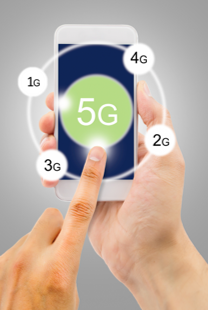Cellular networks are getting an upgrade with the arrival of fifth generation, or "5G," technology. As with previous generations, consumers can expect new applications and improved user experiences.
Beyond mobile phones, powerful advances in connectivity made possible through 5G will enable uses ranging from telemedicine to helping communities manage local resources such as traffic signals and water supplies. 5G will support a growing number of connected devices expected to improve the quality and efficiency of all sorts of products and services consumers enjoy today. Other potential applications include augmented reality, virtual reality and self-driving cars. Learn more about what to expect with the arrival of 5G:
What is 5G?
5G stands for the fifth generation of mobile communications. This next generation of technology promises consumers faster data rates with lower latency, or delays, in transmitting data. It also promises more capacity for a more efficient network. 5G is being designed with flexibility in mind, to support future services and applications that may not even exist today.
How is 5G different from 4G?
5G technology can provide higher data speeds with less delay than 4G, sometimes referred to as 4G LTE. Some 5G services will provide coverage areas with data speeds up to 100 times faster and almost instantaneous response time. For example, it can take almost six minutes to download a feature-length movie with 4G. With 5G, the same movie can be downloaded in as little as 15 seconds. Technically speaking, current 4G speeds are approximately 12-36 megabytes per second (Mbps), while 5G services are expected to support speeds of up to 300 Mbps or greater.
When will 5G be available?
5G technology requires upgraded cellular networks as well as devices capable of accessing these new networks. 5G networks are already being deployed in some parts of the country. Check with your mobile provider for detailed information about its 5G deployment plans.
Will a 5G phone work where 5G service is limited or unavailable?
The 5G phones currently on the market are "backward compatible," meaning that they are capable of functioning on earlier-generation networks outside of 5G coverage areas.
Will a 3G or 4G phone continue to work?
4G devices will continue to work. Mobile providers are expected to maintain their 4G networks as they invest in 5G deployment. If your mobile device is more than a few years old, it may be a 3G device. Check with your mobile provider to see if it plans to phase out its 3G services.
Will 5G work on existing devices built for 3G or 4G?
No. New devices will be required. This includes mobile phones and other cellular devices, such as tablets and smart watches. Before purchasing a 5G device, check with your mobile provider to see if 5G service is available in your area.
Can I use an unlocked 5G device on any network?
While many mobile phones purchased today are "unlocked" so you can change providers, 5G phones – even if advertised as unlocked – may not function on another provider's 5G network. Early 5G-capable devices may only include specific antennas designed to work with one company's 5G services. Check the device's specifications for the different frequencies it works with and compare that to those used by the providers you are considering.
What about 5G home broadband service?
5G home broadband service is available in some markets as an alternative to DSL, Fiber or Cable services. If you subscribe to 5G home broadband service, you will need compatible equipment.
My home wi-fi router has 5G in its name, do I already have 5G at home?
No. The 5G label on a home Wi-Fi router indicates that it operates in the 5GHz (gigahertz) spectrum band. Wi-Fi is based on a different technology than 5G or fifth-generation wireless.
What is the FCC's role in 5G?
The FCC is pursuing a comprehensive strategy to facilitate U.S. 5G deployment. This strategy includes three key components: pushing more spectrum into the marketplace; updating infrastructure policy; and modernizing outdated regulations. For more information, see the FCC web page: America's 5G Future.
The Five G's – A Chronology

5G – Rolling Out Now
Promises faster data rates and energy savings. Enhances existing networks and ushers in new uses like telemedicine and virtual reality.
4G – Streaming Video
Faster data downloads and uploads, support for data-intensive applications, gaming services, mobile TV, video conferencing, and other high-speed features.
3G – Internet and Video
Enabled full-feature mobile internet access and video calling, with faster data transmission speeds.
2G – Messaging
Replaced analog with a digital network. Enabled call and text encryption, text, and multimedia messaging.
1G – Wireless Calling
Eliminated the need for phone cords and copper wiring, enabling network calls on the go. Voice only. Poor battery life and voice quality.
Plan Ahead for 3G Phase Out
You may need to upgrade your device if your mobile provider plans to shut down its 3G network. Plans and timing to phase out 3G services will vary by company. Learn more about how to plan for the phase out of 3G networks and services.